The Influence of Campus Landscape Color Environment on Students’ Emotions: A Case Study of Shandong Agricultural University
Abstract
1. Introduction
2. Materials and Methods
2.1. Research Area
2.2. Image Acquisition
2.3. Image Color Quantization
2.4. Experimental Design
2.4.1. Participants
2.4.2. EEG Index Testing and Experiment Procedure
2.4.3. Psychological Indicator Test
2.4.4. Data Analysis
3. Results
3.1. Environmental Color Analysis
3.2. Physiological Data Analysis
3.3. Subjective Evaluation Analysis
3.4. Composite Analysis of Physiological Data and Subjective Evaluation
4. Discussion
4.1. The Causes for Color Formation in Different Periods
4.2. The Impact of Color Environment on Emotions
4.3. Campus Color Optimization Recommendations Based on Research Findings
- (1)
- Teaching areas: Buildings and pavements are recommended to adopt warm color schemes with neutral brightness and neutral saturation. For instance, brick red and orange-red can serve as primary colors, complemented by a small amount of navy-blue glass for decoration, paired with yellowish-green vegetation. This configuration maintains a moderate level of cognitive activation while preventing excessive tension.
- (2)
- Living areas: Building colors should preferably be selected from high-brightness, neutral–low-saturation warm tones (e.g., beige or off-white), combined with yellowish-green vegetation to create a warm social ambiance.
- (3)
- Learning areas: Buildings and pavements should utilize warm color schemes with high brightness and low saturation, such as light reddish brown and off-white, integrated with a high proportion of emerald green vegetation to alleviate academic pressure.
- (4)
- Sports areas: Runways and similar facilities are advised to adopt cool color schemes with high brightness and neutral saturation (e.g., sky blue or teal), accentuated by a small amount of high-saturation red to stimulate vitality. Buildings in this area are suitable for light grayish yellow, paired with emerald green plants.
4.4. Limitations and Future Research
- (1)
- The sampling season of this test was summer. While the outdoor space included plant elements, this study did not account for seasonal changes. In the future, research could focus on exploring the impact of seasonal changes in plant colors on human emotions.
- (2)
- As a pilot study with a relatively small sample size (N = 30), this research primarily aimed to validate the methodological feasibility of using VR+EEG technology to investigate the mechanisms of color’s influence on emotions within campus environments and to provide preliminary evidence and direction for subsequent large-scale studies. Future studies will expand the sample size to further demonstrate the generalizability of this research’s conclusions.
- (3)
- Additionally, human perception of the environment is not limited to visual attributes (e.g., colors); it also includes spatial layout, sound, and other sensory stimuli. In future research, these factors can be integrated to investigate the mechanism by which outdoor environments influence human emotions.
5. Conclusions
- (1)
- Compared with the new campus, the old campus (SDAU-I) increased the physiological relaxation index (α wave) by up to 11.04% due to its lush emerald green vegetation and light-grayish-yellow building colors, thereby more effectively promoting students’ emotional relaxation.
- (2)
- The emotional regulatory effect of environmental colors is influenced by a combination of hue, lightness, and saturation. Environmental colors with high lightness and low saturation tend to promote greater relaxation. This effect is also closely tied to the composition of environmental elements. The environmental colors of older campuses (characterized by a high proportion of plant colors and a low proportion of building and pavement colors) with long histories are more conducive to students’ emotional relaxation.
- (3)
- In campus outdoor environments, neutral colors like emerald green and teal, as well as high-lightness warm tones such as off-white and beige, induce greater relaxation. Among these, green is the most effective at stimulating relaxation-related brainwave signals.
- (4)
- Color selection guidelines for functional areas are important.Sports areas: The optimal color layout is defined by sky blue and teal tracks, vibrant pure red accents on sports facilities, emerald green vegetation, and light-grayish-yellow buildings. Living areas: It is recommended to adopt beige and off-white for building colors, paired with yellowish-green plants to create a warm atmosphere. Teaching areas: To balance relaxation and concentration, warm-toned building colors such as brick red and orange red can be adopted, complemented by yellowish-green vegetation. However, the saturation of these building colors should be moderated, avoiding the use of overly bright shades in large areas. Learning areas: As spaces dedicated to quiet and focused independent thinking, buildings should primarily feature light reddish brown and off-white, complemented by emerald green vegetation. In conclusion, campus planning must shift its focus from fleeting color trends to the scientifically substantiated impact of color on mental well-being, adopting extensive green vegetation alongside light grayish yellow and off-white as a foundational palette to create restorative landscapes that effectively alleviate student stress.
Author Contributions
Funding
Institutional Review Board Statement
Informed Consent Statement
Data Availability Statement
Conflicts of Interest
References
- Sarkodie, S.A.; Owusu, P.A. Global assessment of environment, health and economic impact of the novel coronavirus (COVID-19). Environ. Dev. Sustain. 2021, 23, 5005–5015. [Google Scholar] [CrossRef] [PubMed]
- Zhang, Z.; Wang, T.; Kuang, J.; Herold, F.; Ludyga, S.; Li, J.; Hall, D.L.; Taylor, A.; Healy, S.; Yeung, A.S.; et al. The roles of exercise tolerance and resilience in the effect of physical activity on emotional states among college students. Int. J. Clin. Health Psychol. 2022, 22, 100312. [Google Scholar] [CrossRef] [PubMed]
- Ohrnberger, J.; Fichera, E.; Sutton, M. The relationship between physical and mental health: A mediation analysis. Soc. Sci. Med. 2017, 195, 42–49. [Google Scholar] [CrossRef] [PubMed]
- Tzouvara, V.; Kupdere, P.; Wilson, K.; Matthews, L.; Simpson, A.; Foye, U. Adverse childhood experiences, mental health, and social functioning: A scoping review of the literature. Child Abus. Negl. 2023, 139, 106092. [Google Scholar] [CrossRef]
- Ding, Y.; Lee, C.A.; Chen, X.; Song, Y.; Newma, G.; Lee, R.Y.J.; Lee, S.M.; Li, D.Y.; Sohn, W. Exploring the association between campus environment of higher education and student health: A systematic review of findings and measures. Urban For. Urban Green. 2024, 91, 128168. [Google Scholar] [CrossRef]
- Yao, C.; Tian, T.; Gao, C.; Zhao, S.; Liu, Q. Visual performance of painting colors based on psychological factors. Front. Psychol. 2022, 13, 966571. [Google Scholar] [CrossRef]
- Townsend, J.; Barton, S. The impact of ancient tree form on modern landscape preferences. Urban For. Urban Green. 2018, 34, 205–216. [Google Scholar] [CrossRef]
- Lyu, M.; Qu, G.; Shi, J.X.; Sun, D.; Tian, Y. A Method for Studying Building Color Harmony in Coastal Historic and Cultural Districts: A Case Study of Mojiko, Japan. Buildings 2025, 15, 15091496. [Google Scholar] [CrossRef]
- Blaszczyk, R.L. The Architectonic Colour: Polychromy in the Purist Architecture of LeCorbusier. J. Des. Hist. 2011, 24, 405–407. [Google Scholar] [CrossRef]
- Li, X.; Zhang, Z.; Gu, M.; Jiang, D.; Wang, J.; Lv, Y.M.; Zhang, Q.; Pan, H. Effects of plantscape colors on psycho-physiological responses of university students. J. Food Agric. Environ. 2012, 10, 702–708. [Google Scholar] [CrossRef]
- Hedblom, M.; Gunnarsson, B.; Iravani, B.; Knez, I.; Schaefer, M.; Thorsson, P.; Lundström, J.N. Reduction of physiological stress by urban green space in a multisensory virtual experiment. Sci. Rep. 2019, 9, 10113. [Google Scholar] [CrossRef] [PubMed]
- Lin, C.-T.; Chang, C.-J.; Lin, B.-S.; Hung, S.-H.; Chao, C.-F.; Wang, I.-J. A Real-Time Wireless Brain-Computer Interface System for Drowsiness Detection. IEEE Trans. Biomed. Circuits Syst. 2010, 4, 214–222. [Google Scholar] [CrossRef] [PubMed]
- Hao, J.; Gao, T.; Qiu, L. How do species richness and colour diversity of plants affect public perception, preference and sense of restoration in urban green spaces? Urban For. Urban Green. 2024, 100, 128487. [Google Scholar] [CrossRef]
- Li, X.; Ni, G.; Dewancker, B. Improving the attractiveness and accessibility of campus green space for developing a sustainable university environment. Environ. Sci. Pollut. Res. 2019, 26, 33399–33415. [Google Scholar] [CrossRef]
- Wankhade, M.; Rao, A.C.S.; Kulkarni, C. A survey on sentiment analysis methods, applications, and challenges. Artifcial Intell. Rev. 2022, 55, 5731–5780. [Google Scholar] [CrossRef]
- Browning, M.H.E.M.; Mimnaugh, K.J.; van Riper, C.J.; Laurent, H.K.; LaValle, S.M. Can Simulated Nature Support Mental Health? Comparing Short, Single-Doses of 360-Degree Nature Videos in Virtual Reality with the Outdoors. Front. Psychol. 2020, 10, 2667. [Google Scholar] [CrossRef]
- Flavián, C.; Ibáñez-Sánchez, S.; Orús, C. The impact of virtual, augmented and mixed reality technologies on the customer experience. J. Bus. Res. 2019, 100, 547–560. [Google Scholar] [CrossRef]
- Shen, Z.; Liu, F.; Huang, S.; Wang, H.; Yang, C.; Hang, T.; Tao, J.; Xia, W.; Xie, X. Progress of flexible strain sensors for physiological signal monitoring. Biosens. Bioelectron. 2022, 211, 114298. [Google Scholar] [CrossRef]
- Wang, X.; Ren, Y.; Luo, Z.; He, W.; Hong, J.; Huang, Y. Deep learning-based EEG emotion recognition: Current trends and future perspectives. Fronitiers Psychol. 2023, 14, 1126994. [Google Scholar] [CrossRef]
- Li, Y.; Zheng, W.; Wang, L.; Zong, Y.; Cui, Z. From Regional to Global Brain: A Novel Hierarchical Spatial-Temporal Neural Network Model for EEG Emotion Recognition. IEEE Trans. Affect. Comput. 2022, 13, 568–578. [Google Scholar] [CrossRef]
- Hong, Y.K.; Cho, J.Y. Characteristics of physical environments that enhance learning: A systematic review of EEG-Based empirical studies. J. Environ. Psychol. 2025, 102, 102525. [Google Scholar] [CrossRef]
- Tost, H.; Champagne, F.; Meyer-Lindenberg, A. Environmental influence in the brain, human welfare and mental health. Nat. Neurosci. 2015, 18, 1421–1431. [Google Scholar] [CrossRef] [PubMed]
- Mohan, U.R.; Zhang, H.; Ermentrout, B.; Jacobs, J. The direction of theta and alpha travelling waves modulates human memory processing. Nat. Hum. Behav. 2024, 8, 1124–1135. [Google Scholar] [CrossRef] [PubMed]
- Peng, Y.; Li, Y.; Cheng, W.; Wang, K. Evaluation and Optimization of Sense of Security during the Day and Night in Campus Public Spaces Based on Physical Environment and Psychological Perception. Sustainability 2024, 16, 1256. [Google Scholar] [CrossRef]
- Zhang, J.; Liu, S.; Liu, K.; Bian, F. How does campus-scape influence university students’ restorative experiences: Evidences from simultaneously collected physiological and psychological data. Urban For. Urban Green. 2025, 107, 128779. [Google Scholar] [CrossRef]
- Wang, Z.; Li, K.; Dou, L.; Xu, Z.; Liu, J. The recovery effect of plant color on the negative emotions of college students. J. Northwest For. Univ. 2018, 33, 290–296. [Google Scholar] [CrossRef]
- Wang, T.; Li, Y.; Tian, L.; Mou, S.; Zhang, X. A Visual Comparative Study of Urban Color Rosearch Methods Based on CiteSpace. Landsc. Archit. Acad. J. 2025, 42, 57–64. [Google Scholar] [CrossRef]
- Wieland, M.; Martinis, S.; Kiefl, R.; Gstaiger, V. Semantic segmentation of water bodies in very high-resolution satellite and aerial images. Remote Sens. Environ. 2023, 287, 113452. [Google Scholar] [CrossRef]
- Liu, B.; Xue, Y.; Li, M.; Zhu, X.; Pan, Y.; Tian, A.; Li, S.; Xu, J. Vortex spatial phase-shifting digital microscopic holography based on pixel traversal. Opt. Lasers Eng. 2025, 190, 108933. [Google Scholar] [CrossRef]
- Zhou, W.; Dong, S.; Fang, M.; Yu, L. CACFNet: Cross-Modal Attention Cascaded Fusion Network for RGB-T Urban Scene Parsing. IEEE Trans. Intell. Veh. 2024, 9, 1919–1929. [Google Scholar] [CrossRef]
- Wan, X.; Liu, J.; Gan, X.; Liu, X.; Wang, S.; Wen, Y.; Wan, T.; Zhu, E. One-Step Multi-View Clustering with Diverse Representation. IEEE Trans. Neural Netw. Learn. Syst. 2024, 36, 5774–5786. [Google Scholar] [CrossRef]
- Premalatha, V.; Parveen, N. Concurrent attentional reconstruction network for 3D point cloud reconstruction from single image. Appl. Soft Comput. 2025, 172, 112821. [Google Scholar] [CrossRef]
- Liu, W.; Li, J.; Rong, H.; Zhou, Z. Constructing a Mathematical Model of Product Color Design Based on Data Mining: Case Study of a Thermos Cup. Coatings 2024, 14, 209. [Google Scholar] [CrossRef]
- Yao, Y.; Zhu, X.; Xu, Y.; Yang, H.; Wu, X.; Li, Y.; Zhang, Y. Assessing the visual quality of green landscaping in rural residential areas: The case of Changzhou, China. Environ. Monit. Assess. 2012, 184, 951–967. [Google Scholar] [CrossRef]
- Barham, M.P.; Clark, G.M.; Hayden, M.J.; Enticott, P.G.; Conduit, R.; Lum, J.A.G. Acquiring research-grade ERPs on α shoestring budget: α comparison of a modified Emotiv and commercial SynAmps EEG system. Psychophysiology 2017, 54, 1393–1404. [Google Scholar] [CrossRef]
- Debener, S.; Minow, F.; Emkes, R.; Gandras, K.; De vos, M. How about taking a low-cost, small, and wireless EEG for a walk? Psychophysiology 2012, 49, 1617–1621. [Google Scholar] [CrossRef]
- Wang, X.; Rodiek, S.; Wu, C.; Chen, Y.; Li, Y. Stress recovery and restorative effects of viewing different urban park scenes in Shanghai, China. Urban For. Urban Green. 2016, 15, 112–122. [Google Scholar] [CrossRef]
- Miller, B.; Simmering, M. Attitude Toward the Color Blue: An Ideal Marker Variable. Organ. Res. Methods 2023, 26, 409–440. [Google Scholar] [CrossRef]
- Pion-Tonachini, L.; Kreutz-Delgado, K.; Makeig, S. ICLabel: An automated electroencephalographic independent component classifier, dataset, and website. Neuroimage 2019, 198, 181–197. [Google Scholar] [CrossRef]
- Ji, P.; Zhang, L.; Gao, Z.; Ji, Q.; Xu, J.; Chen, Y.; Song, M.; Guo, L. Relationship between self-esteem and quality of life in middle-aged and older patients with chronic diseases: Mediating effects of death anxiety. BMC Psychiatry 2024, 24, 7. [Google Scholar] [CrossRef] [PubMed]
- Cho, K.A.; Seo, Y.H. Dual mediating effects of anxiety to use and acceptance attitude of artificial intelligence technology on the relationship between nursing students’ perception of and intention to use them: A descriptive study. BMC Nurs. 2024, 23, 212. [Google Scholar] [CrossRef]
- Shah, W.U.; Hao, G.; Yan, H.; Shen, J.; Yasmeen, R. Forestry Resource Efficiency, Total Factor Productivity Change, and Regional Technological Heterogeneity in China. Forests 2024, 15, 152. [Google Scholar] [CrossRef]
- Zhang, Y.; Schoonjans, Y.; Gantois, G. The emergence and evolution of workers’ villages in early New China. Plan. Perspect. 2024, 39, 153–177. [Google Scholar] [CrossRef]
- He, J. Concept·Practice·Outlook—Contemporary Campus Planning and Design. China Sci.2010, 7, 489–493. Available online: https://qikan.cqvip.com/Qikan/Article/Detail?id=34835829 (accessed on 5 November 2025).
- Fanea-Ivanovici, M.; Baber, H. Sustainability at Universities as a Determinant of Entrepreneurship for Sustainability. Sustainability 2022, 14, 454. [Google Scholar] [CrossRef]
- Lowe, R.A.; Knight, R. Building the ivory tower: The social functions of late nineteenth century collegiate architecture. Stud. High. Educ. 2006, 7, 81–91. [Google Scholar] [CrossRef]
- Peng, X.; Jin, Y.; Sun, J.; Zhao, L.; Liu, S.Y.Y.; Li, R. Exploring the effect of stress arousal on the positive emotional design of multimedia learning. Educ. Inf. Technol. 2024, 29, 20267–20298. [Google Scholar] [CrossRef]
- Zheng, S.; Zhou, Y.; Qu, H. Physiological and psychological responses to tended plant communities with varying color characteristics. J. For. Res. 2024, 35, 32. [Google Scholar] [CrossRef]
- Wang, F.; Yang, L.; Sun, Y.; Cai, Y.; Xu, X.; Liu, Z.; Liu, Q.; Zhao, H.; Ma, C.; Liu, J. A Nanoclay-Enhanced Hydrogel for Self-Adhesive Wearable Electrophysiology Electrodes with High Sensitivity and Stability. Gels 2023, 9, 323. [Google Scholar] [CrossRef] [PubMed]
- Jang, H.S.; Gim, G.M.; Jeong, J.S.; Kim, J.S. Changes in physiologi-caland psychological conditions of humans to color stimuli of plants. J. People Plants Environ. 2019, 2, 127–143. [Google Scholar] [CrossRef]
- Lu, S.; Oh, W.; Ooka, R.; Wang, L. Effects of Environmental Features in Small Public Urban Green Spaces on Older Adults’ Mental Restoration: Evidence from Tokyo. Int. J. Environ. Res. Public Health 2022, 19, 5477. [Google Scholar] [CrossRef]
- Yang, M.; Dijst, M.; Faber, J.; Helbich, M. Using structural equation modeling to examine pathways between perceived residential green space and mental health among internal migrants in China. Environ. Res. 2020, 183, 109121. [Google Scholar] [CrossRef]
- Zhang, N.; Zhao, L.; Shi, J.; Gao, W. Impact of visual and textural characteristics of street walls on stress recovery. Sci. Rep. 2024, 14, 15115. [Google Scholar] [CrossRef]
- Sun, Y.; Qi, N.; Zhan, J.; Yin, J. The Impact of Cool and Warm Color Tones in Classrooms on the Perceived Emotions of Elementary School Students in Northwest China. Buildings 2024, 14, 3309. [Google Scholar] [CrossRef]
- Song, L.; Zhang, G.; Ma, L.; Silvennoinen, J.; Cong, F. Comparative analysis of color emotional perception in art and non-art university students: Hue, saturation, and brightness effects in the Munsell color system. BMC Psychol. 2025, 13, 650. [Google Scholar] [CrossRef]
- Li, Z.; Hu, L.; Lin, A.L.; Chen, J.; Xu, Y. The greener, the richer, the happier?—Spatial distribution and coupling analysis of urban green space and residents’ emotion based on social media data. Ecol. Indic. 2025, 177, 113754. [Google Scholar] [CrossRef]
- Nakshian, J.S. The Effects of Red and Green Surroundings on Behavior. J. Gen. Psychol. 1964, 70, 143–161. [Google Scholar] [CrossRef]
- Taylor, C.; Franklin, A. The relationship between color-object associations and color preference: Further investigation of ecological valence theory. Psychon. Bull. Rev. 2012, 19, 190–197. [Google Scholar] [CrossRef]
- Wilms, L.; Oberfeld, D. Color and emotion: Effects of hue, saturation, and brightness. Psychol. Res. 2018, 82, 896–914. [Google Scholar] [CrossRef]
- Liu, X.L.; Zhang, F.Y.; Gao, Q.R.; Li, T.L.; Zhang, R.H.; Jia, Y.Y. Optimizing the Ecological Network to Construct an EcologicalSecurity Pattern in a Metropolitan Area: A Case Study of theJinan Metropolitan Area, China. Sustainability 2025, 17, 7342. [Google Scholar] [CrossRef]
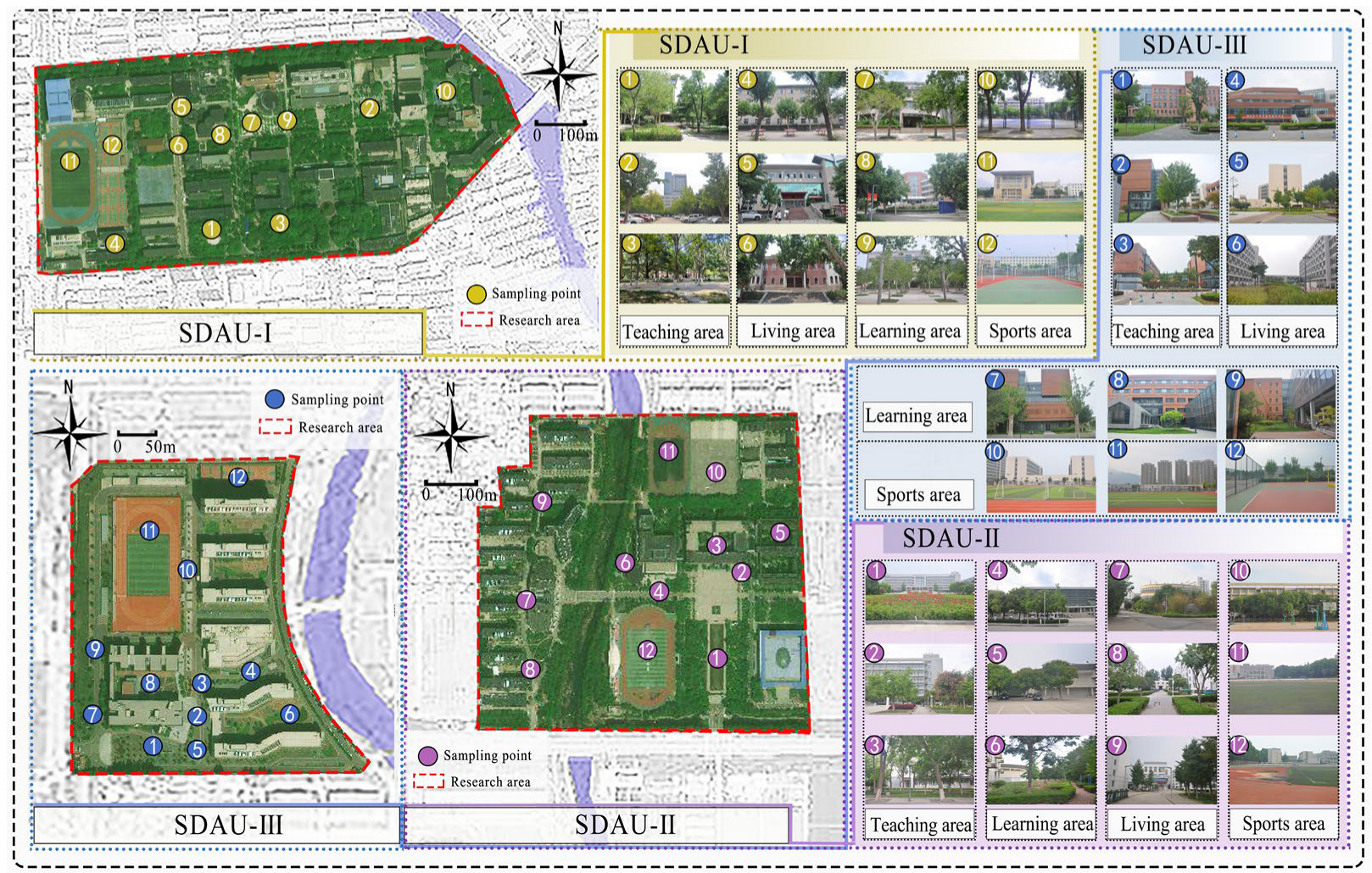
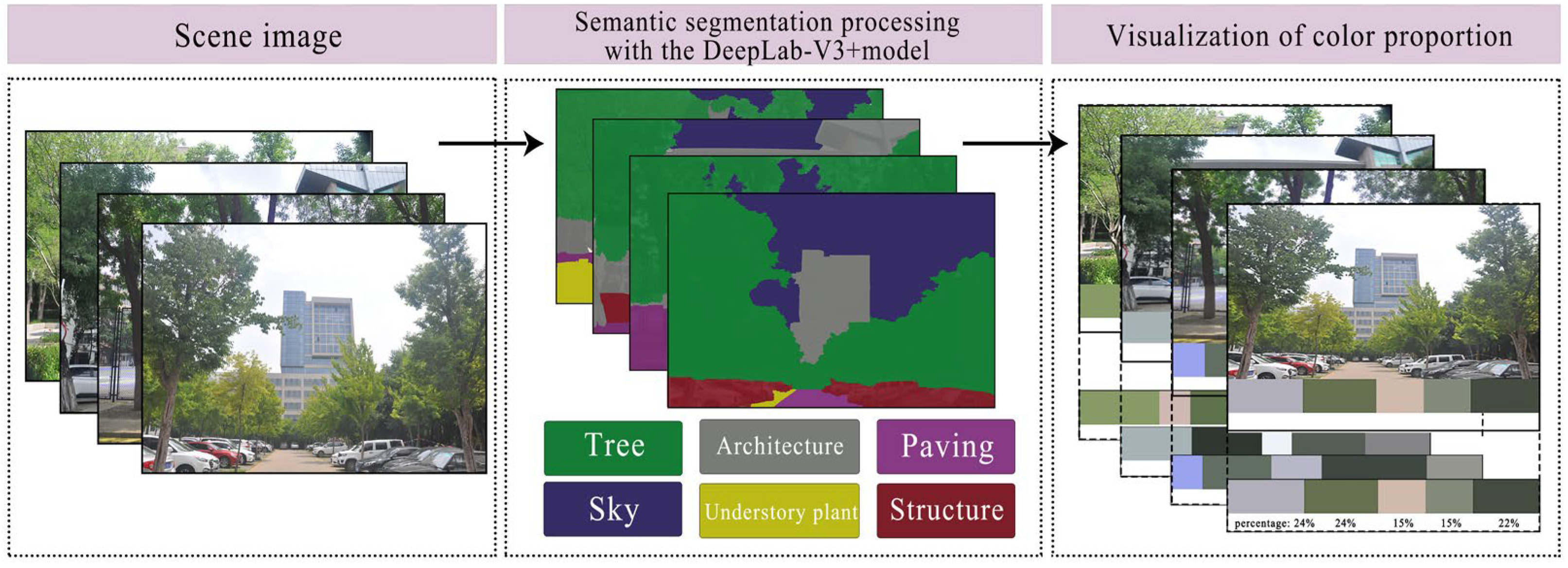
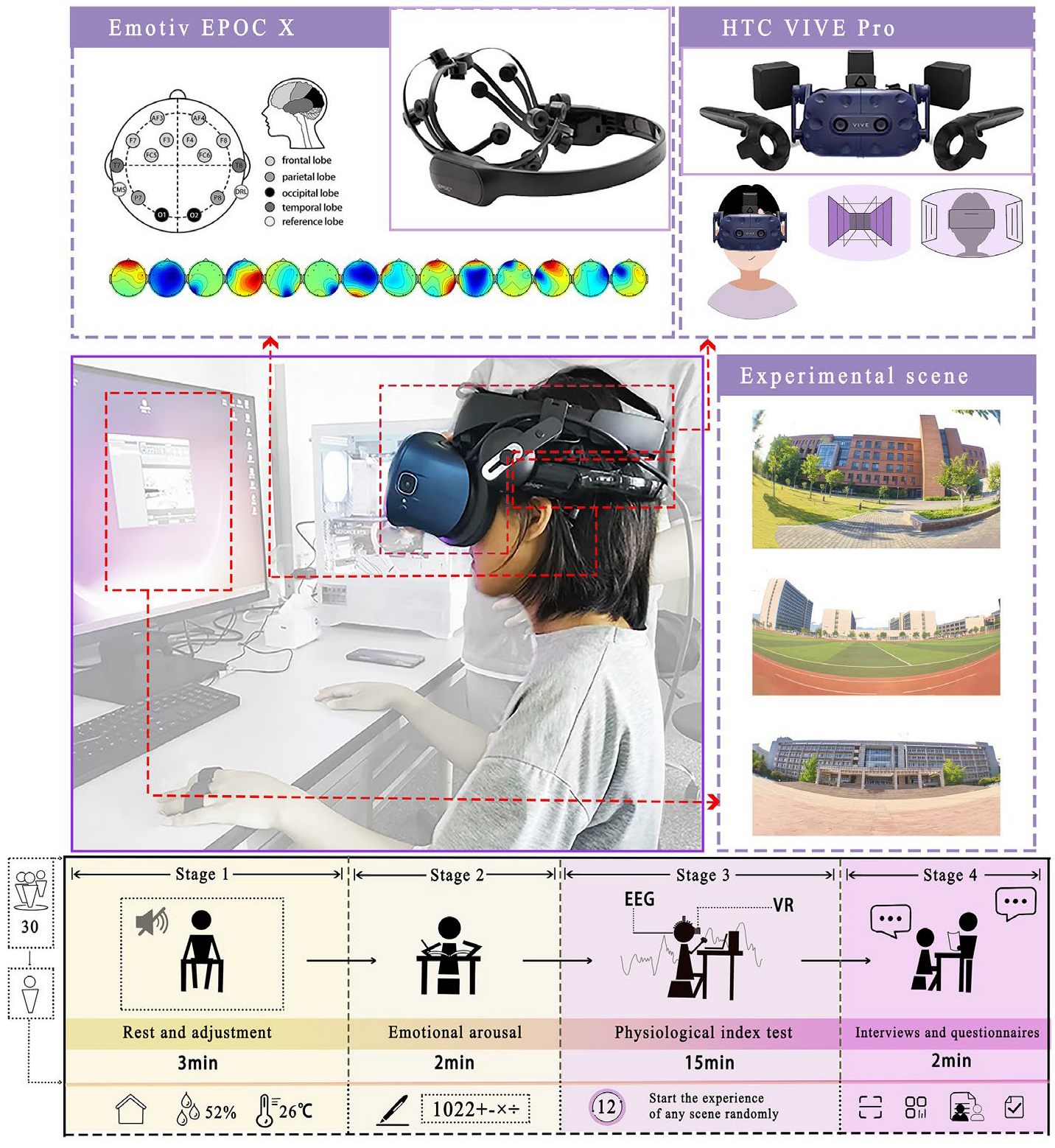
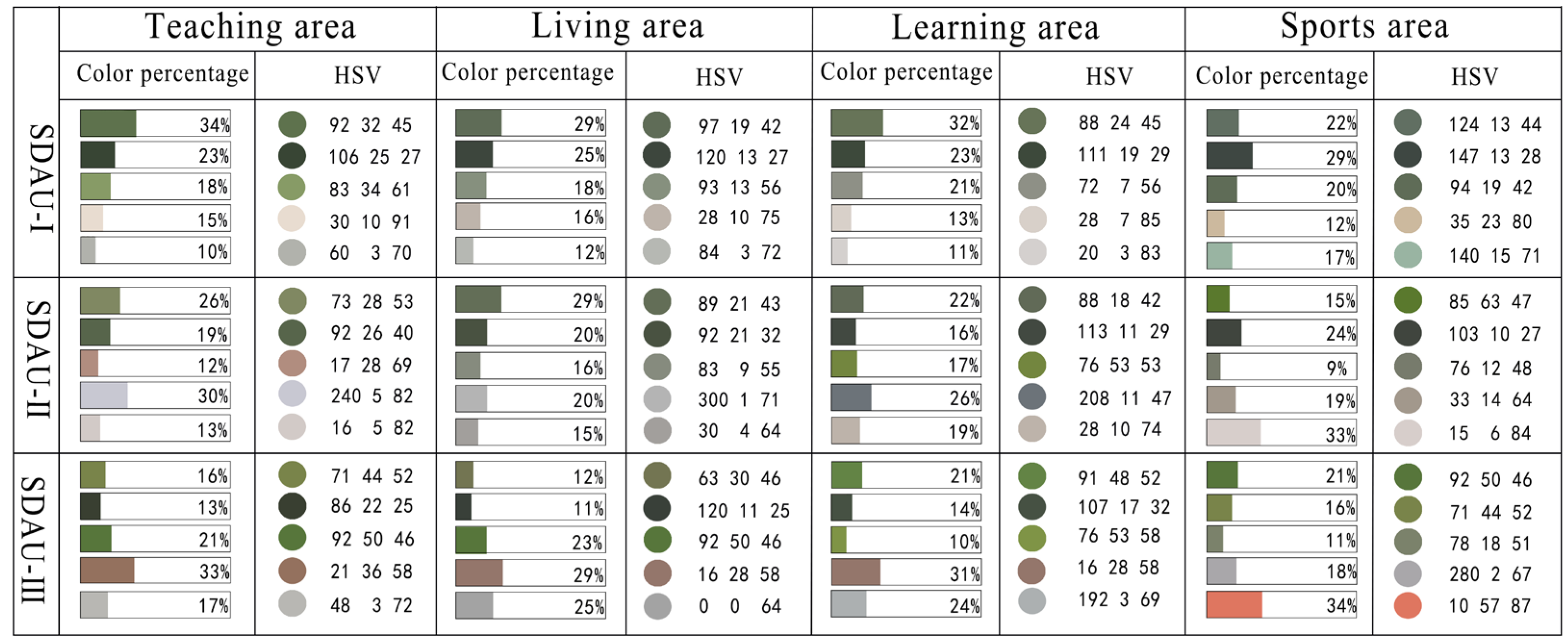




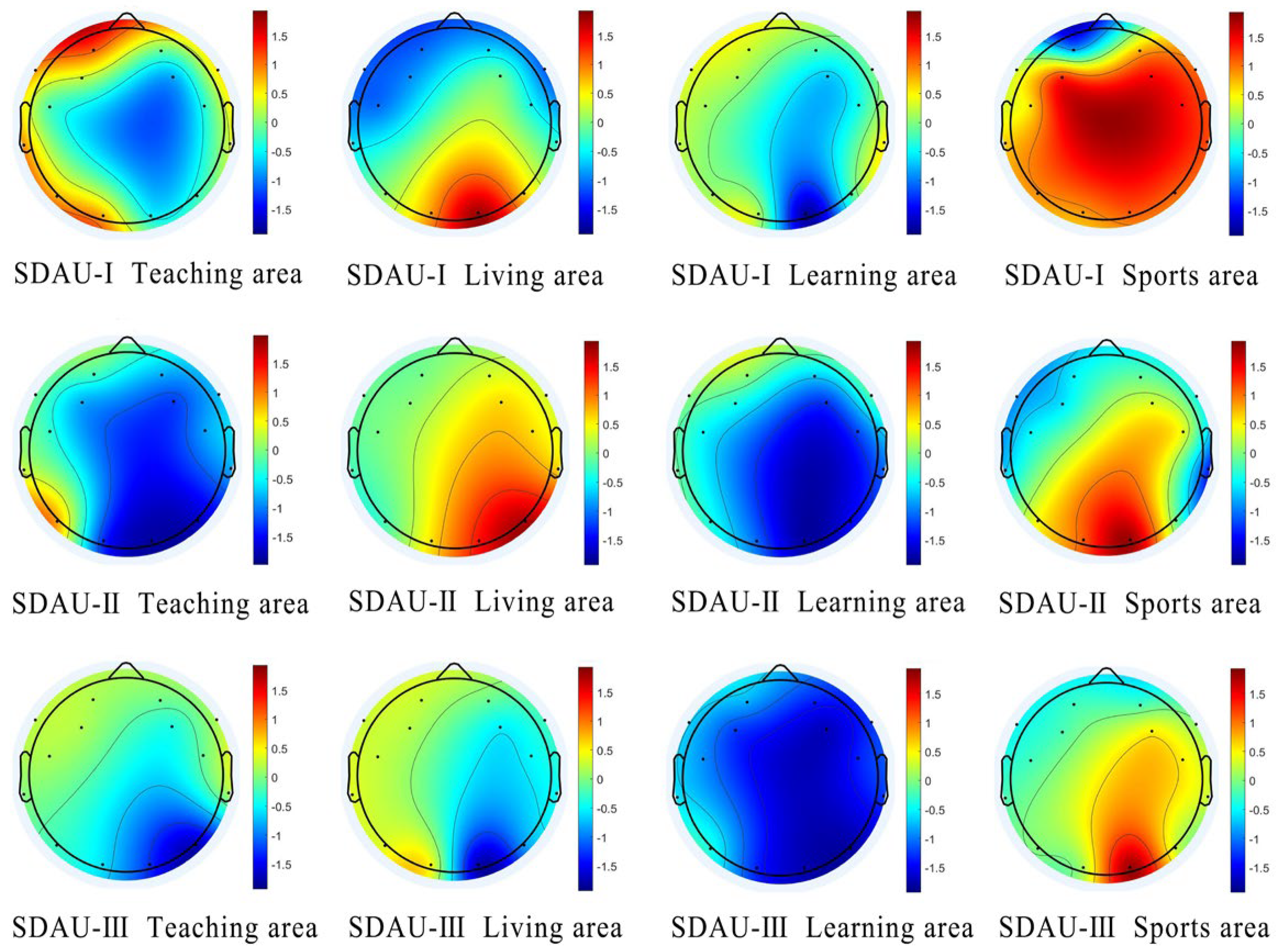
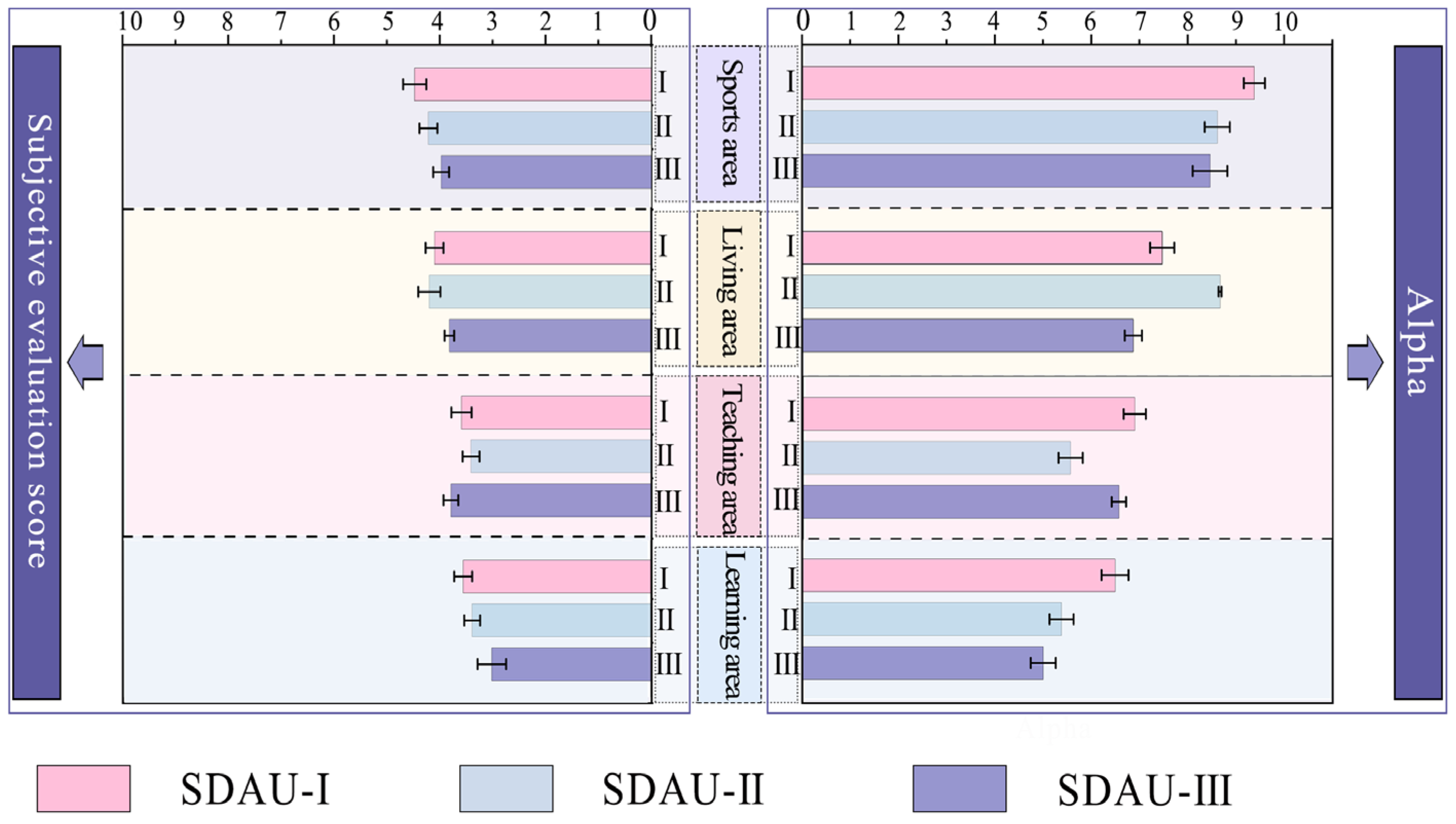
| Campus | Functional Zoning | N | α Wave | Subjective Evaluation Scores | ||
|---|---|---|---|---|---|---|
| Mean + SD | p-value | Mean + SD | p-value | |||
| SDAU-I | Teaching area | 30 | 6.89 ± 0.23 | 0.013 * | 3.61 ± 0.19 | <0.0001 ** |
| Living area | 30 | 7.47 ± 0.25 | <0.0001 ** | 4.10 ± 0.17 | 0.002 * | |
| Learning area | 30 | 6.49 ± 0.28 | <0.0001 ** | 3.56 ± 0.17 | 0.021 * | |
| Sports area | 30 | 9.39 ± 0.22 | <0.0001 ** | 4.49 ± 0.22 | <0.0001 ** | |
| SDAU-II | Teaching area | 30 | 5.56 ± 0.25 | <0.0001 ** | 3.43 ± 0.16 | <0.0001 ** |
| Living area | 30 | 8.67 ± 0.03 | <0.0001 ** | 4.20 ± 0.21 | 0.004 * | |
| Learning area | 30 | 5.38 ± 0.25 | 0.016 * | 3.39 ± 0.15 | 0.024 * | |
| Sports area | 30 | 8.62 ± 0.26 | 0.024 * | 4.23 ± 0.17 | <0.0001 ** | |
| SDAU-III | Teaching area | 30 | 6.56 ± 0.15 | <0.0001 ** | 3.81 ± 0.14 | <0.0001 ** |
| Living area | 30 | 6.87 ± 0.18 | <0.0001 ** | 3.82 ± 0.09 | 0.012 * | |
| Learning area | 30 | 5.00 ± 0.26 | 0.009 * | 3.02 ± 0.27 | 0.037 * | |
| Sports area | 30 | 8.47 ± 0.36 | 0.011 * | 3.99 ± 0.15 | <0.0001 ** | |
Disclaimer/Publisher’s Note: The statements, opinions and data contained in all publications are solely those of the individual author(s) and contributor(s) and not of MDPI and/or the editor(s). MDPI and/or the editor(s) disclaim responsibility for any injury to people or property resulting from any ideas, methods, instructions or products referred to in the content. |
© 2025 by the authors. Licensee MDPI, Basel, Switzerland. This article is an open access article distributed under the terms and conditions of the Creative Commons Attribution (CC BY) license (https://creativecommons.org/licenses/by/4.0/).
Share and Cite
Li, Y.; Yu, Y.; Hu, D.; Shang, X.; Wang, T.; Liu, K.; Mou, S.; Zhang, X. The Influence of Campus Landscape Color Environment on Students’ Emotions: A Case Study of Shandong Agricultural University. Buildings 2025, 15, 4290. https://doi.org/10.3390/buildings15234290
Li Y, Yu Y, Hu D, Shang X, Wang T, Liu K, Mou S, Zhang X. The Influence of Campus Landscape Color Environment on Students’ Emotions: A Case Study of Shandong Agricultural University. Buildings. 2025; 15(23):4290. https://doi.org/10.3390/buildings15234290
Chicago/Turabian StyleLi, Yingjie, Ying Yu, Dingmeng Hu, Xinyue Shang, Tianyu Wang, Keran Liu, Siwei Mou, and Xinwen Zhang. 2025. "The Influence of Campus Landscape Color Environment on Students’ Emotions: A Case Study of Shandong Agricultural University" Buildings 15, no. 23: 4290. https://doi.org/10.3390/buildings15234290
APA StyleLi, Y., Yu, Y., Hu, D., Shang, X., Wang, T., Liu, K., Mou, S., & Zhang, X. (2025). The Influence of Campus Landscape Color Environment on Students’ Emotions: A Case Study of Shandong Agricultural University. Buildings, 15(23), 4290. https://doi.org/10.3390/buildings15234290





